Electric vehicles can consume half of your home’s electrical capacity or at least a considerable portion of it. Simply adding a charger can easily cause overload for properties that do not have a large amount of unused power capacity left. Increasing the power capacity for your home is expensive. Using a smart Dynamic Load Balancing system can help avoid that cost and still charge your electric vehicle at the maximum possible speed. This article explains simple and relatively inexpensive ways to get your EV charged every time without overloading the property’s electrical capacity.
The examples used here are relevant to private houses. If you live in an apartment or condo, then make sure to check the last paragraph of this article for additional steps required for them.
What is Dynamic Load Balancing for EV charging?
Dynamic Load Balancing (DLB) is a smart solution that allows you to safely balance the power consumption between your electric vehicle and your other electrical home appliances. The remaining available energy will be used to charge your car in the most efficient way. If you own more than one charging station, electricity will be evenly distributed to all vehicles charging at the same time as long as there is sufficient capacity. This ensures that the network is not overloaded.
Below is a typical power capacity graph of a property with peak demand in the morning and the evening. Usually, this is comfortably below the power capacity limit of a house or apartment. On average, the power consumption reaches its peak in the morning when people get out of bed and in the evening, when workers come home from work and kids come back from school.
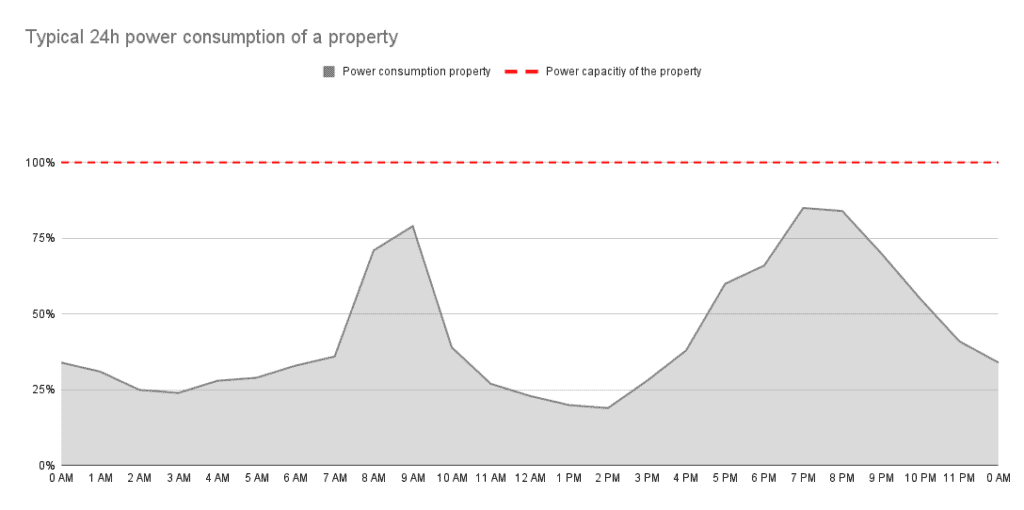
In all of the examples below, we assume that the owner arrives home at 6 PM, plugs in their EV, and starts to use other electrical appliances in the house. This causes the peak consumption to be highest at those hours.
Adding an EV chargers consumption on top of this can cause the electrical system to become overloaded:
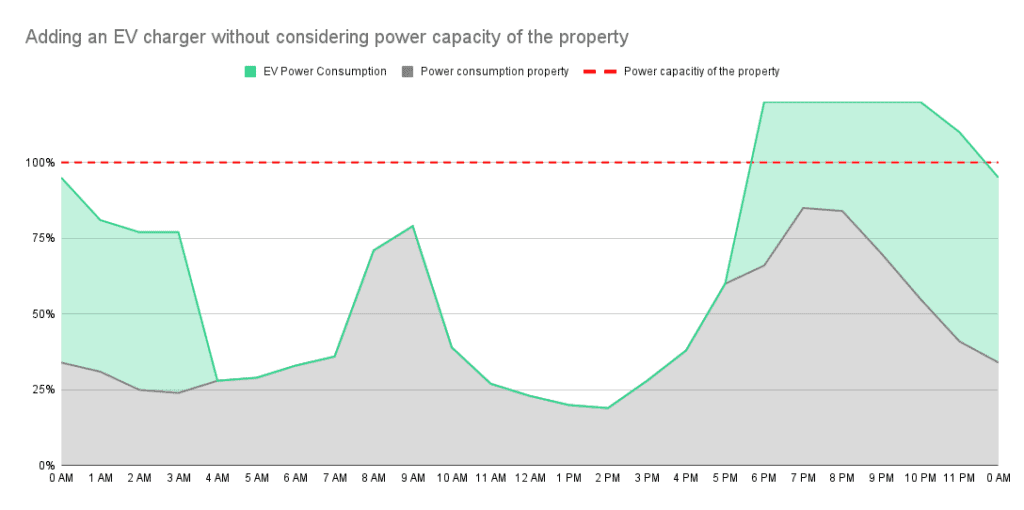
The term “overload” can sound dangerous but this is exactly why the circuit breaker is for – it turns off power to prevent an actual overload. When this happens you are left with a dark house until you flip the circuit breaker back online.
The best way to avoid exceeding the power capacity is by using Dynamic Load Balancing.
Most convenient and future-proof solution out there. You can just plug in the car any time and most of the time your car will charge with the maximum possible current. You can comfortably turn on the water heater, electric stove, iron, other electrical appliances and still plug in your car comfortably.
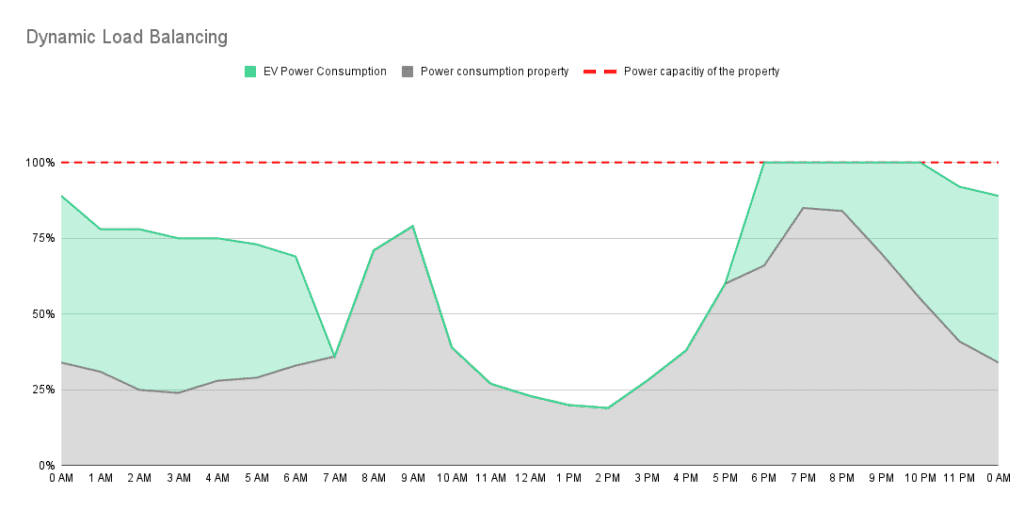
The system measures the power consumption of the house or apartment and allocates all available power to your EV. Even if you buy an EV with a bigger battery and higher charging rate you can be certain, that you charge with maximum available power, regardless of the time of the day.
Pros and Cons of Dynamic Load Balancing
Pros:
- Install and forget solution
- No upgrade is needed when buying a new car with a higher charging rate
- The system can easily be upgraded to accommodate 2 or more EV chargers
Cons:
- Installation is trickier upfront
- Extra energy meter and data cable adds to the installation cost
Do I need DLB or does my property has enough electrical capacity?
The easiest way is to have your electrician determine it. Assuming you already have a charger and you are looking for someone to install it then a professional EV charger installer will ask you about the free electrical capacity of the property. This can be determined in three ways starting with the easiest:
- Call your power utility company and ask how much unused power capacity your property has
- Have an electrician measure or calculate it
- Check online. Some power utility companies have this info online as long as you have an account and log-ins. Look for “power consumption” or “used connection capacity”
- Calculate it. Main fuse rating – current draw from electrical appliaences = free electrical capacity
Take into account that not all electrical appliances will be working simultaneously.
Alternative ways to avoid exceeding the power capacity of the property
Although using DLB is considered the best option for the majority of the users it is not the only option.
Limiting the power output of the charger
Most wall-mounted home chargers, even simple ones, have a dip switch which enables to limit the output power. This requires opening the casing and can be done with relatively little knowledge about electrical appliances.
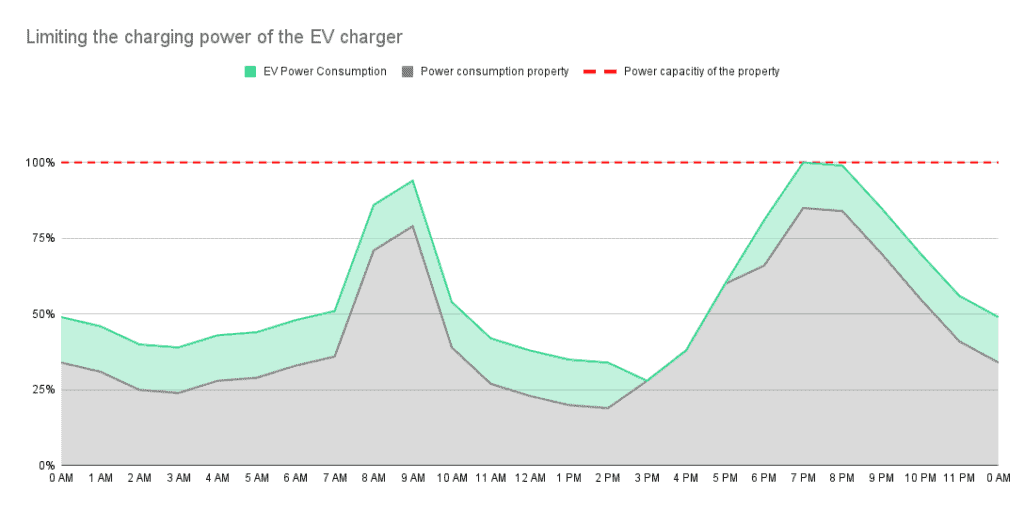
Pros:
- A dip switch is relatively easy to adjust and does not require an electrician
- No extra expenses, since most chargers have a dip switch
Cons:
- Charging times are extended considerably
- Not a future proof solution in case you plan to add more electrical appliances
Many EVs come with a cable adapter that plugs into your wall socket and the other end to your car’s charging port. These units do not have an adjustable dip switch.
Programming the charger to charge at night
Usually, the electricity costs less during nighttime. Therefore many EV users set their charger to only charge at night time. Since the power usage of the building is lower during the night time you can be quite certain that you will not overload your electrical system
The drawback is the fact that sometimes you do need a charge in the evening or during the daytime.
This option requires a smart charger – one that has a mobile interface or an app. Sometimes they have their internet access, sometimes they can be accessed using a WiFi network.
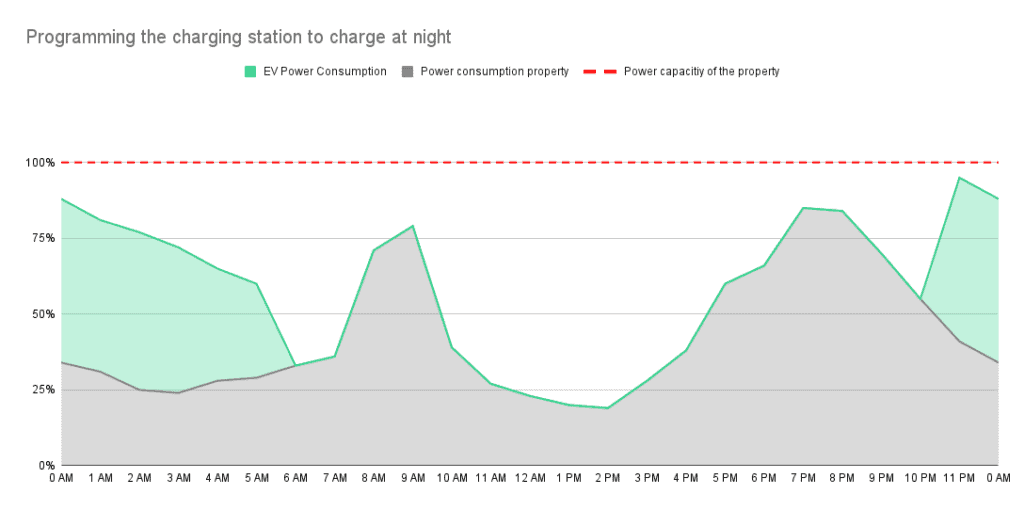
Pros:
- Most smart chargers can be programmed
- Chargers can be retrofitted with a timer
- Will work with adding new electrical appliances
Cons:
- Charging during peak demand is restricted
Dynamic Load Balancing will work for you even if you add a second EV charger
DLB is extremely future-proof. Even if you buy another EV, this does not overload the electrical systems of the property, and DLB systems can support several chargers.
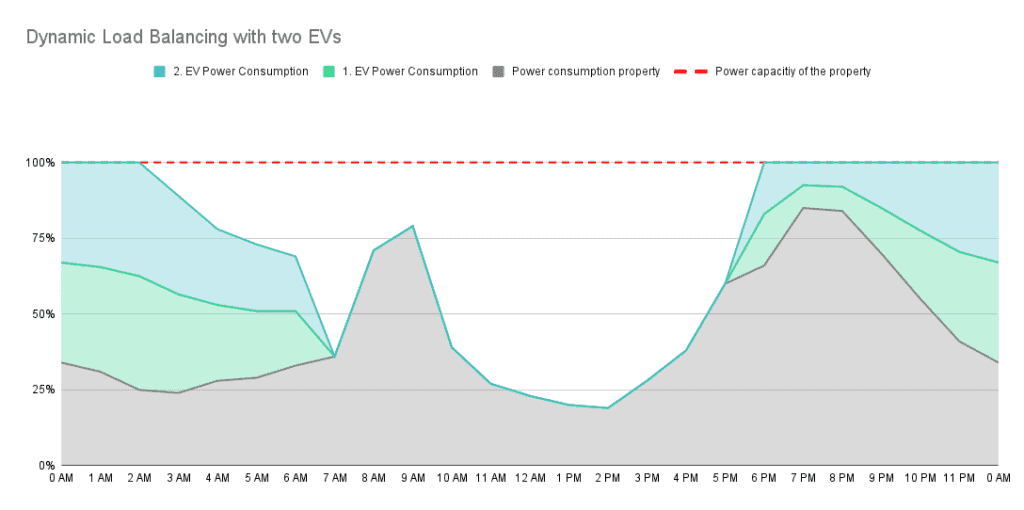
How does the installation work?
Here is how an electrician installs the dynamic load balancing:
- The electrician will install an extra energy meter before the main fuse of the property. This measures how much power the property is currently using.
- The electrician brings a data cable from the new energy meter to the charger. This enables the charger to know how much electrical power the property is using.
- After knowing the usage data and main fuse size, the charger can calculate how much power is available and adjust the charging current accordingly.
- If a second charger is installed, then one of the chargers will be on

What if you live in an apartment or condominium?
The last paragraph explained how one of the chargers can become the master charger, which controls the other chargers. The drawback here is that if the master charger is offline, then all the chargers are offline. Therefore apartments and condos must use a switchboard to control the chargers.

The future-proof option is to choose an OCPP 1.6 charger. This means, that the charger can be connected to the internet and the billing can also occur there.
Also, keep in mind that your energy meter must be connected to your apartment in the case of multi-family buildings or just have a separate energy meter.
Conclusion: the upfront investment into installing Dynamic Load Balancing will be worth it
It is not too difficult to retrofit your charger with DLB in the future. At the same time, you will likely buy more and more electrical appliances which will all eat into the free electrical capacity. EVs charging power is likely to increase, and you may even think about buying another EV with a second charger. Investing in increasing the property’s electrical capacity will almost always be many times higher. Also, in many parts of the world, it will increase your monthly electrical bill. Investing in Dynamic Load Balancing will be worth it – you may even forget that you installed it and it is a great compliment to the technology.